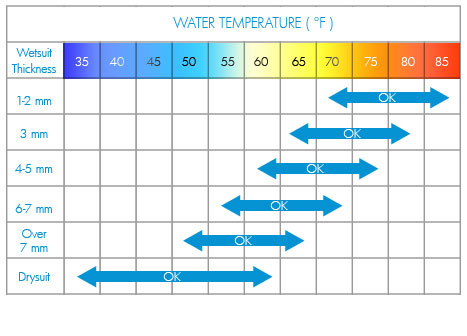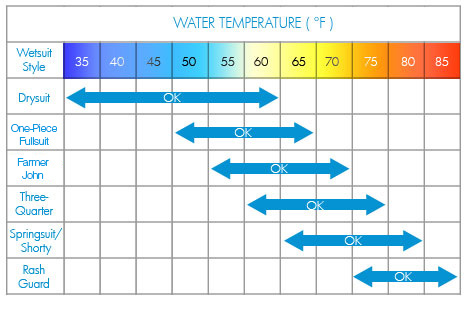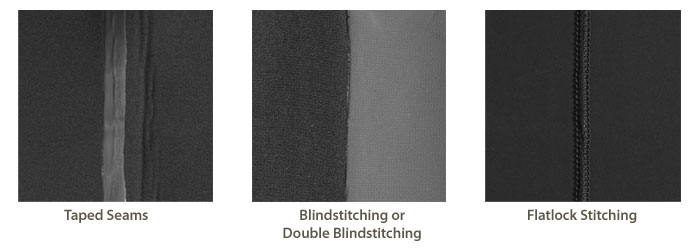
-

Wetsuits are made of a closed-cell synthetic material called foam neoprene, which is often combined with a laminate material. Thinner, non-foam neoprene, which looks just like rubber, is used to create the neck and wrist gaskets found on semi-dry suits and dry suits. Unlike natural rubber, neoprene is more resistant to deterioration caused by sunlight and general wear. Without additional insulation, water pulls heat away from your body 25 times faster than air. If you feel cold when the air temp is 60°F, just imagine how quickly you’ll lose body heat in 60°F water. To combat that heat loss, a wetsuit wraps your body in thick foam neoprene, which offers more insulation and buoyancy than other waterproof materials.
Unlike a dry suit, a wetsuit isn’t completely watertight, and allows small amounts of water to enter the suit, usually through the arm, leg and neck openings or through the zipper. This thin layer of water remains against your skin, but is much easier for your body to warm than the surrounding water outside the suit. Wetsuits are also designed to minimize the exchange of water between the interior and exterior, so your body doesn’t have to work as hard to stay warm. The thicker the neoprene, the more insulation it provides.
-

When buying a wetsuit, you should focus on three primary factors: 1) the right fit, 2) the right thickness, and 3) the right amount of coverage.
Wetsuit Fit
Choosing a suit that fits is very important. A loose wetsuit will allow too much water inside, and won’t insulate well. Suits that are too tight will be uncomfortable and restricting. Your wetsuit should fit snugly, but not so much that it hampers your movement. It’s a good idea to refer to a manufacturer’s size chart, if available. If you’re shopping for wetsuits on this website, simply click on the sizing tab to view a chart, or hover over the item’s available size options to view ideal height and weight ranges for each size.
Neoprene Thickness
Neoprene thickness is represented in millimeters. Neoprene used for wetsuits typically ranges between 1mm and 10mm, and most wetsuits are designed for water temps ranging between 45° and 80°F. If the water temp is above 80°F, a lightweight rash guard and swimsuit will probably be sufficient. For water colder than 45°F, you may need a dry suit. Some wetsuits utilize two thicknesses of neoprene to minimize unnecessary bulk. For example, a 3/2mm wetsuit has 3mm neoprene around the torso for increased warmth and 2mm neoprene around the limbs for flexibility.
Scuba divers should also be aware that increased pressure during deep dives can compress a wetsuit, causing it to lose some of its insulating capability. This means greater depths require a thicker wetsuit or dry suit, especially for long dives in deep water.
Quick Tip: As a general rule, wetsuits lose about half of their insulating power at a depth of 60 feet, and even more as you descend deeper.
Best Wetsuit Thickness by Water Temperature

Coverage
Wetsuits are available in a wide range of styles, including lightweight shorty wetsuits, sleeveless Farmer John suits, fullsuits and several other variations. The type of activity you are doing will help determine the ideal wetsuit. For example, surfers usually require less insulation and coverage than divers, because they spend much less time fully submerged. The following section provides an overview of the most common styles of wetsuits and dry suits.
-

Wetsuits and dry suits are used for many different aquatic activities, including scuba diving, surfing, wakeboarding, water skiing, kayaking and triathlons. Choosing a suit is a matter of balancing insulation and coverage with the flexibility required for your activity.
Wetsuits
Wetsuit Jackets and Vests are typically made of thinner neoprene, and may be worn over a swimsuit for added core warmth when a rash guard isn’t enough. A wetsuit jacket can also be combined with a sleeveless wetsuit for more versatility than a one-piece wetsuit.
Springsuits or “shorty wetsuits” are one-piece suits with short sleeves and short legs. They are generally not very thick (usually in the 2-4mm range), but provide more insulation than a vest or jacket. Surfers, wakeboarders and water skiers often prefer a shorty wetsuit for warmer conditions.
Speedsuits and Swimskins are lightweight, one-piece wetsuits designed to give triathletes and long-distance swimmers maximum freedom of movement.
Three-Quarter Wetsuits are one-piece wetsuits that combine short sleeves with full-length legs, and are ideal for moderate conditions.
Fullsuits, sometimes called “steamers,” are one-piece, full-length wetsuits that cover the entire body. They come in a wide range of thicknesses, from 3/2mm versions for surfing to 7mm versions for cool-water scuba diving.
Farmer John Wetsuits (or Farmer Jane for women), are sleeveless, one-piece wetsuits that cover the entire leg. This style is a favorite of kayakers who require maximum arm mobility, and because they are easy to combine with a paddling jacket or splash top for colder conditions.
Semi-Dry Suits
A semi-dry wetsuit is a full-length, one-piece wetsuit with added features designed to provide greater insulation and minimize the amount of water that enters the suit. This typically involves adding synthetic rubber gaskets to the wrist and ankle openings, and possibly the neck opening as well. Semi-dry wetsuits frequently incorporate a special laminated membrane on the interior for added warmth.
Dry Suits
Designed to completely seal out water during dives and rescue swimming operations in very cold conditions, a dry suit combines a one-piece, waterproof suit with water-tight gaskets at the wrists, neck and ankles for maximum protection. Once combined with a hood, mask, gloves and dive boots, dry suits only leave small portions of the face exposed. Generally, there are two kinds of dry suits: a neoprene dry suit and a membrane dry suit.
Neoprene Dry Suits are very similar to semi-dry wetsuits, except with more robust gaskets and a water-tight zipper or closure system. For added warmth, a neoprene dry suit may be worn over a base layer for additional protection from the cold, especially during deep dives.
Membrane Dry Suits are created using a layered, waterproof material, such as laminated nylon and rubber. Unlike a neoprene dry suit, membrane suits do not provide any flotation or insulation from the cold and must be combined with a heavyweight base layer for warmth.
Best Wetsuit Style by Water Temperature

Note: These are general ratings only. A person scuba diving in 65°F water will need more wetsuit than someone surfing in the same water, since he or she will be submerged the entire time. Also, for colder water temperatures, it’s assumed that accessories like a hood, gloves and neoprene boots will also be worn.
-
Foam Neoprene
Polychloroprene was first introduced by DuPont in the early 1930s as an alternative to rubber. Foam neoprene is a spongy, stretchy, closed-cell variant created by injecting polychloroprene with nitrogen. Neoprene is waterproof, and also provides better insulation and durability than natural rubber. According to surf lore, back in the 1940s, a man named Jack O'Neill first noticed neoprene lining the aisle of a passenger jet, and decided to try using the material to create a surfing wetsuit. While the exact details are disputed by some, O'Neill and Body Glove are widely considered to be among the first to experiment with neoprene as a wetsuit material in the 1950s, and have been improving on it ever since. Today, other major wetsuit manufacturers include Camaro of Austria, Zoot Sports and Jet Pilot.
Wetsuit Laminates
Originally, wetsuits were made from sheets of raw foam neoprene, which could tear easily and would stick to the skin when wet. For this reason, surfers and divers would powder the insides of their suits with talc, making them easier to put on. Later, nylon was laminated to the inside of wetsuits for added durability and ease of entry. An outer membrane helps wetsuits resist tearing and abrasions, and a smooth inner lining makes them easier to put on and take off. Modern wetsuits often offer laminates made from a blend of nylon and spandex for added flexibility. Some brands also use polypropylene.
Super-Stretch Neoprene
Although industry terminology varies, “super-stretch neoprene” offers much better elasticity and is often combined with traditional neoprene to create surfing wetsuits and triathlon wetsuits, or “speedsuits.” These will typically utilize super-stretch neoprene at the back, shoulders, arms and sides of the torso to enhance freedom of movement. Some high-end surfing and triathlon wetsuits may use all super-stretch neoprene for maximum flexibility.
-

Taped Seams
When a wetsuit description lists “taped seams,” it means that nylon tape with a rubber backing has been glued over the seams, covering up the stitching. This tape helps minimize the entry of water and reduces abrasion against the skin. Although some wetsuits offer fully taped seams to keep water out, most modern suits are taped at specific stress points only. Liquid seam tape may also be used as a more flexible alternative to nylon tape.
Glued Seams
This construction method involves adhering neoprene together with glue for a smooth, flat seam. However, gluing raw neoprene together without stitching produces a weaker bond that is more likely to fail, which is why glued seams are not commonly used on newer wetsuits.
Blindstitching & Double Blindstitching
Blindstitching uses a combination of seam gluing and sewing halfway through the material with a special curved needle. This prevents cold water from seeping through the tiny stitching holes and into the suit. Double blindstitching involves stitching both sides of the fabric for added strength, with neither stitch going all the way through the fabric. Blindstitching allows virtually no water to penetrate, and appears mainly in high-end wetsuits and semi-dry suits. However, it’s also less durable than other types of stitching. For this reason, it’s typically only used on suits made of thicker neoprene.
Flatlock Stitching
Flatlock stitching is primarily reserved for warm-water wetsuits used in very active watersports, such as surfing, water skiing, wakeboarding and windsurfing. Flatlock stitching provides excellent flexibility and strength, and because the stitches are designed to lay flat and not push into skin, it helps minimize abrasion. However, this type of seam lets water through, so it isn't ideal when insulation is a top priority.
-

Built-In Hoods are offered on some wetsuits, semi-dry suits and dry suits. A hood is essential for cold-water scuba diving, and can also be beneficial for surfing in off-season conditions. Some wetsuits and dry suits are designed to be used with a separate hood.
Gaskets are rubber seals located at the wrists, ankles and neck that prevent water from penetrating a suit. They appear on some wetsuits, most semi-dry suits and all dry suits.
Touch-Fasten Neck Seals keep the neck zipper in place and prevent water from flowing into an otherwise loose opening.
Flex Zones or four-way stretch zones increase mobility in some wetsuits. The flex is concentrated in the areas where you need it most, such as the knees, elbows and shoulders.
Floodgates are interior zipper flaps that minimize the flow of water through a wetsuit zipper.
Extended Zipper Pulls make it easier to put on a wetsuit with a rear entry zipper.
Knee Pads add durability to the knee section of a wetsuit, which is a high wear area.
Titanium Lining is a thin, pliable, woven metal lining layered inside a wetsuit to help reflect heat back to the body. A coating of titanium oxide can also be applied to the interior of the wetsuit, usually in the torso region, for added heat reflection.
-

Wetsuit Hoods are vital when staying submerged in very cold water. Typically used by divers, a wetsuit hood is designed to insulate the head, neck and chin. When combined with a facemask, only a small portion of the face is left exposed.
Neoprene Gloves are essentials for diving in cold water, and can also be used for wakeboarding. Neoprene gloves often have reinforced palms so they won't wear out from repeated gripping.
Neoprene Booties or Diving Boots provide insulation in cold water and help protect feet from abrasion when using large swim fins. Diving boots usually have durable rubber soles for traction and protection from the ocean floor or lake bottom. They are also great for rafting and kayaking. Some brands like Camaro of Austria also make neoprene boots designed specifically for surfers.
Neoprene Vests can be worn over a rash guard for extra core protection, or layered under a wetsuit.
-
As wetsuits get older, they will naturally stiffen, crack and compress due to the effects of sunlight, salt water, overstretching, etc. In order to slow down this process and get the most out of your wetsuit, follow these simple care, storage and cleaning guidelines:
- Always rinse your wetsuit well with fresh water after every use, especially after use in salt water
- When not being used, always store your wetsuit out of direct sunlight, since UV radiation and heat will damage it
- Never put a wetsuit in the dryer or near any other heat source
- Don't overstretch your suit, as this can lead to cracking. This can be avoided by not buying a wetsuit that is too small
- Fix wetsuit leaks and holes with neoprene glue as soon as they appear to prevent further damage to your wetsuit